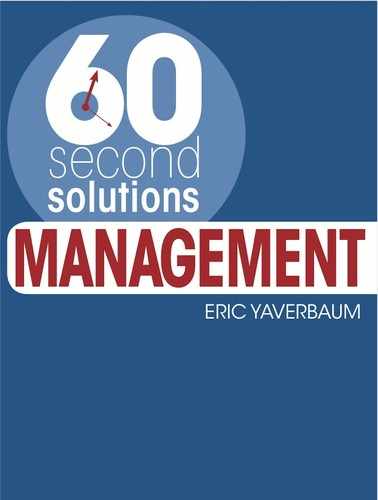SOLUTION 25
DECODING BODY LANGUAGE
‘I speak two languages, Body and English.’Mae West
More than half of all communication is conveyed in our body language, the unspoken messages that our posture and gestures convey.
Body language often reflects subconscious messages, the content of communication that escapes the intellect’s control and manipulation. In other words, your body doesn’t always tell the same story as your words. Understanding this can be a powerful tool in reinforcing the messages you give your team and in hearing what they have to say to you.
IDENTIFY THE WARNING SIGNS
An employee may be saying one thing, but his body language may reveal a different message. Without knowing it, he will disclose what he is really feeling if you know what to look out for:
The manager’s eyes wander to the computer screen rather than focusing on the person in front of him. His arms cross and his foot starts to jiggle. His words say: ‘You did a great job with the presentation. I’ve had phone calls from several people saying how much they enjoyed it.’ But his body says: ‘Will she never leave? I have a conference call in ten minutes, and I have to finish the budget report by 4…’ The account executive sitting across from him hears she’s doing a great job, but his body language is sending out different signals.
Feet dragging Implies lethargy.
Head down Suggests timidity.
Shoulders drooped A sign of weariness.
Slovenly posture May no longer care.
Shifty eyes and fidgeting May indicate nervousness.
Arms crossed on chest A defensive stance.
Hands in pockets He may be hiding something from you.
body language: the unspoken messages that a person’s posture and gestures convey
QUICK FIX: POSITIVE MESSAGES
You can greatly improve the consistency between your words and your body language. Here are a few tips:
| WHAT YOU SAY | WHAT YOU SHOULD DO |
| ‘I think you are doing a great job.’ | Maintain eye contact It’s okay to look away now and then; this is not a stare-down. |
| ‘I want to hear how I can help you.’ | Open your posture If seated, let your arms rest on the chair arms; if standing, let them hang naturally at your sides. |
| ‘I want to know how you would tackle this task.’ | Sit alongside Sitting directly opposite can be confrontational. |
| ‘I’m interested in what you have to say.’ | Don’t play with your hair, jewellery, pen It’s important to be engaged. |
